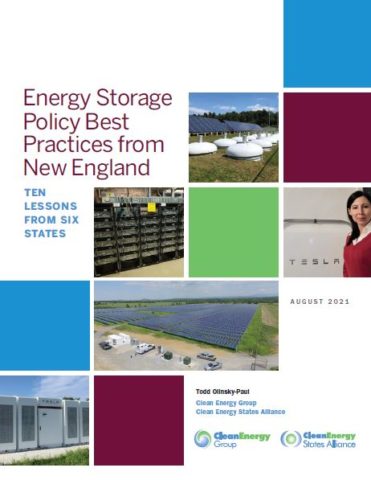Energy Storage Policy Best Practices from New England: Ten Lessons from Six States
Todd Olinsky-Paul | Clean Energy Group / Clean Energy States Alliance
This report explores energy storage policy best practices and lessons learned from the New England states. It aims to inform state policymakers and regulators seeking to expand energy storage markets.
New England has taken a leadership position in energy storage policy development, with several states implementing first-in-the-nation programs. As a result, energy storage deployment in the region has leapt ahead of many areas of the country. About 20 MW of grid-scale battery storage projects have come online in the region since 2015, but this is only the precursor to a much larger expected level of growth. According to ISO New England, energy storage now accounts for 15 percent (3,771 MW) of the region’s proposed new energy resources.
New England states have been particularly successful in innovating policies and programs to support distributed or behind-the-meter (BTM) energy storage—both to provide resilient power to homes and businesses, and to contribute regional electricity services through virtual power plant (VPP) structures. Every state in the region now has some variety of BTM storage funding program. In Vermont, for example, Green Mountain Power’s residential battery program has placed battery systems in more than 3,000 homes; the utility dispatches this aggregated, distributed energy storage resource to reduce peak demand, saving ratepayers millions of dollars. And Connecticut’s new Electric Storage Program aims to incentivize 10,000 new residential battery systems in the next three years.
Though there are many successes, the report notes that challenges remain. Even where states have taken the lead in goal setting and program implementation, energy storage uptake has sometimes been hampered by interconnection barriers, out-of-date regulations, and immature markets. Many of the potential health, safety, efficiency, and economic benefits that can be provided by energy storage are still not monetizable. And despite having the greatest need for these benefits, low-income and underserved communities in New England have not yet gained equitable access to energy storage and related clean energy technologies.
The report aims to provide state policymakers and regulators with a set of principles and lessons learned from experience in New England, as well as several other leading states. While the report does not prescribe a particular suite of energy storage policies, it does provide recommendations that each state should consider as it charts its own course. State policy and program resources for policymakers are listed in the Appendix.
This report was supported by the Merck Family Fund and the Barr Foundation, and by Clean Energy Group’s Resilient Power Project.
Associated Project(s):
Resource Details:
Date: August 5, 2021
Type: Report
Topic(s): Energy Storage, Resilient Power

